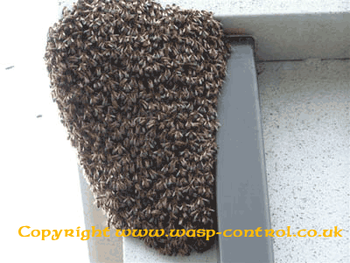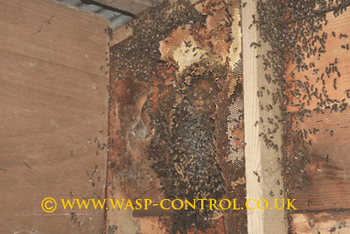Bee Nest Identification
Distinguishing Between Bee Nests and Swarms: Identifying Locations and Key Indicators
Understanding the nuances between bee nests and swarms, their preferred locations, and the signs to watch for is crucial in managing bee-related situations.
When honey bees engage in swarming behavior, it indicates their search for a new nest location. The original colony has outgrown its existing nest, prompting the bees to split in half and form a swarm. However, complications arise when these swarms decide to take up residence in human-inhabited spaces.
During a swarm, scout bees are dispatched to survey the surroundings in search of a suitable nesting location. If you observe a few honey bees displaying interest in a particular area and their numbers steadily increase over a few days, these are likely scout bees. Unfortunately, there is little that can be done during this phase, as the main swarm has not yet arrived. The quantity of scout bees can vary from just a few to several hundred, and interestingly, they can vanish as swiftly as they appeared.
Once a full swarm arrives, the scene can be chaotic, with thousands of bees darting in various directions. However, they quickly settle down and form a cohesive cluster before selecting their new abode. It's worth noting that swarms might abandon a location if it proves inadequate for constructing a new nest.
By recognizing the distinctive characteristics and behaviors associated with both nests and swarms, individuals can better navigate potential interactions with bees and make informed decisions on how to address these situations.

Navigating Bee Nests in Chimneys: Understanding Behavior and Appropriate Responses
Chimneys prove to be a favored nesting site for honey bees, especially during the swarming season in spring/summer when most fireplaces remain inactive, providing an opportune environment for bees to establish colonies.
The arrival of a swarm in a chimney can be unexpected, marked by a sudden surge of buzzing noises emanating from the fireplace and the sight of numerous bees descending down the chimney shaft.
If you find yourself in this unfortunate scenario, a prompt remedy involves lighting a smoky fire, often sufficient to disperse the swarm and encourage them to move on. However, if the bees have occupied the space for an extended period, typically a few days or more, they likely have constructed honeycomb, requiring a different approach for resolution.
It's important to note that, in most instances, extracting and relocating bees from chimneys is a costly option. If treating bees, adherence to bee treatment regulations is paramount, particularly when employing residual insecticides. After the bees have been eliminated, all entrances must be securely blocked.
To identify the presence of bees in a chimney, inspect the top of the chimney pot from the exterior; heightened activity around the pot is indicative. The acoustic cues can also aid in identification - honey bees in chimneys generate considerable noise, especially noticeable when listening to the flue from the fireplace. While wasps may also inhabit chimneys, their numbers are usually lower than bees, and their presence is accompanied by quieter activity.
Importantly, bumblebees typically refrain from nesting in chimneys, providing a helpful distinction in dealing with various bee species. By understanding the behaviors and characteristics associated with bees in chimneys, individuals can adopt appropriate measures for both prevention and resolution.
Addressing Bee Nests in Cavity Walls: Recognizing Species, Behaviors, and Appropriate Measures
Addressing honey bee infestations within the cavities of building walls presents a distinctive challenge, considering the financial impracticality of dismantling brickwork to extract the bees or honeycomb. In situations where intervention is unavoidable, a prevalent method involves treating the bees with a residual insecticide. However, it is essential to exercise caution during this process, as the aftermath may involve unattended honeycomb within the walls. Care should be taken to block the entrances promptly after treatment to thwart other foraging bees from accessing stored honey and to prevent potential re-colonization. Failing to remove the comb post-treatment poses the risk of honey leakage from the now unattended honeycomb, emphasizing the importance of comprehensive care in handling honey bee nests in building walls.
Identifying honey bee infestations in walls becomes apparent when observing bees bringing in pollen on their legs, often manifested as small yellow balls attached to each back leg. The presence of these bees is typically characterized by a sizable population, numbering in the thousands.
A visual aid, such as our short video on honey bees, can further illustrate these distinctive features, emphasizing the yellow marks on the bees, indicative of pollen collection.
Cavity walls also attract bumblebees, who tend to nest not only in the wall cavities but also in air bricks. Distinguished by their rounder and fluffier appearance compared to honey bees, bumblebee colonies are generally smaller, ranging from 50 to 100 bees in total. While bumblebees lack protection status, it is advisable to consider non-destructive measures unless they exhibit heightened aggression or inhabit inconvenient locations that impede safe removal and relocation.

Bee Nests in Bird Boxes: Understanding and Addressing Bumblebee Habitation
When it comes to bee nests in bird boxes, it's highly likely that the occupants are bumblebees. The positive aspect of having bumblebees in bird boxes is that they are generally easy to relocate. If you find yourself with a buzzing colony in your bird box, a recommended course of action involves reaching out to your local pest controller or beekeeper. They are equipped to facilitate the relocation process, usually scheduling this activity in the evening when the bees are less active.
Relocating a bumblebee nest from a bird box to a safer location is a service that is typically offered by local pest controllers or beekeepers, and it's worth noting that there may be a charge associated with this service. This fee is justified by the expertise and care taken in ensuring the safe and humane transfer of the bumblebee colony. It is important to engage with professionals who specialize in the ethical and responsible handling of bee colonies, emphasizing the significance of preserving these essential pollinators.
By contacting local experts, you not only contribute to the well-being of the bumblebee colony but also gain valuable insights into coexisting with these important pollinators. Taking a proactive and informed approach ensures the smooth relocation of bumblebees from bird boxes to a secure and suitable environment, fostering a harmonious balance between human habitation and the preservation of vital bee populations.